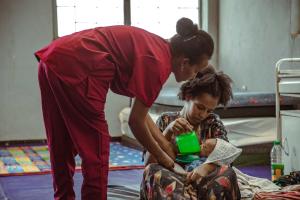Saving lives and building resilience: what we learn from nutrition in emergencies response in Ethiopia during 2023
Ethiopia's conflict-affected regions faced many challenges, including communication disruptions, power outages, and supply shortages. As of May 2023, 22.8 million people in Ethiopia faced food insecurity, lacking sufficient food for consumption. The prevalence of food insecurity in Ethiopia was 22.25 per cent of the population at the time. The situation was further compounded by flooding and mud slides caused by heavy rainfall and river overflows between October and November 2023, approximately 1.5 million people have been affected, mainly in regions such as Somalia, Oromia, Afar, South Ethiopia and Gambella. Amid these adversities, malnutrition emerged as a silent killer, threatening the lives of thousands, particularly children under five. The most recent Food and Nutrition baseline survey (FNS) 2023 revealed that 11 per cent of children under the age of five are acutely malnourished or wasted, and 39 per cent are stunted. The prevalence of wasting among children under five years ranges from as low as 4% in Addis Ababa to as high as 9% in Oromia, 15% in Amhara and Gambella, 17% in Somali, and 26% in the Afar region in relation to climate shocks, conflicts, and diseases outbreaks.
The lack of coordination, inadequate resources, and limited capacity at the grassroots level further exacerbated the situation, leaving communities in desperate need of assistance. According to the latest hotspot classification report in August 2023, there were 154 priority 1 woredas (districts) out of 578 current hotspots. The main causes of the humanitarian crisis were the consecutive failed rainy seasons, the drought in Southern and Southeastern parts of Ethiopia. This year January 2024 hotspot classification showed an increase of woredas classified as priority 1 (219) out of 610 hotspot woredas.
In the face of adversity, the World Health Organization Ethiopia (WHO) nutrition team mobilized resources from partners such as the United Nations Central Emergency Response Fund (CERF) and The United States Agency for International Development/ Bureau of Humanitarian Assistance (USAID/BHA). These resources were used to engage stakeholders and devise innovative strategies to address the crisis head-on. The team laid the groundwork for a comprehensive and sustainable response through regular coordination meetings and collaboration with government agencies, UN bodies, and NGOs, as well as capacity-building efforts at the health facility level.
According to Agnes Charles Kihamia, Technical Nutrition Officer, "Several key strategies and innovations were instrumental in the success of the nutrition emergency response:"
Coordination and Collaboration: By bringing together diverse stakeholders such as government ministries, UN Agencies, local National and International NGOs and fostering partnerships, the team ensured a unified and synchronized effort in addressing the crisis.
Performance Monitoring: Nutrition Surveillance, a robust Systematic monitoring of the diverse range of the information sources on nutrition food, that included detailed nutrition assessments, health facility information, rapid assessments and intervention data were collected, interpreted and distributed, allowed for the timely assessment of interventions, enabling the team to adjust strategies and optimize resource allocation.
Capacity Strengthening: Empowering frontline healthcare workers, particularly healthcare workers, proved crucial in identifying and delivering quality services for managing acute malnutrition at the grassroots level. Through capacity-building initiatives country-wide, 557 and 307 Healthcare Workers (HCWs) enhanced their skills and knowledge on the comprehensive management of acute malnutrition and Infant and Young Children Feeding in Emergencies (IYCF-E) practices.
Resilience and Adaptability: Despite facing numerous challenges, including communication disruptions and supply shortages, the team demonstrated resilience and adaptability, ensuring the continuity of care even in the most adverse conditions through ensuring adequate supplies and equipment. A total of 109.5 MT of Pediatric kit including SAM/MC children Kits that provided medicines, renewables and equipment suitable for children and to treat the common childhood malnutrition with medical complications were distributed worth 878.83 K USD.
As a result
Lives Saved: Through timely interventions and quality care, the team saved countless lives, particularly those of children under five who were most vulnerable to malnutrition-related complications. To date, 38.3% cure at the stabilization centers from breastfeeding difficulties and 54.08% of SAM children with medical complications were stabilized and continued with treatment in the outpatient therapeutic services.
Resilience Built: By strengthening skills and knowledge and fostering partnerships, the response efforts-built strength within communities, enabling them to withstand future crises better.
Sustainability Achieved: The sustainable interventions and capacity-building efforts ensured that the impact of the response extended beyond the immediate crisis, laying the foundation for long-term resilience and well-being. However the malnutrition situation is deteriorating exacerbated by persistent diseases outbreaks, high food prices, inflation, conflict and displacement, posing a continued challenge on response to the needs both for government and WHO operations. This demands urgent and multi-sectoral support in the nutrition and health in addition to food, water , sanitation an hygiene (WASH) to mitigate the wide spread of drought.
WHO deeply appreciates the support of our donor the Central Emergency Response Fund (CERF) and The United State Agency for International Development/ Bureau of Humanitarian Assistance (USAID/BHA . Their contribution made Ethiopia's nutrition emergency response exemplifies the transformative power of coordinated efforts, innovation, and resilience in saving lives and building more robust, more resilient communities. By drawing lessons from this experience, we can continue to improve our response to nutrition emergencies and ensure that no one is left behind in times of crisis.
